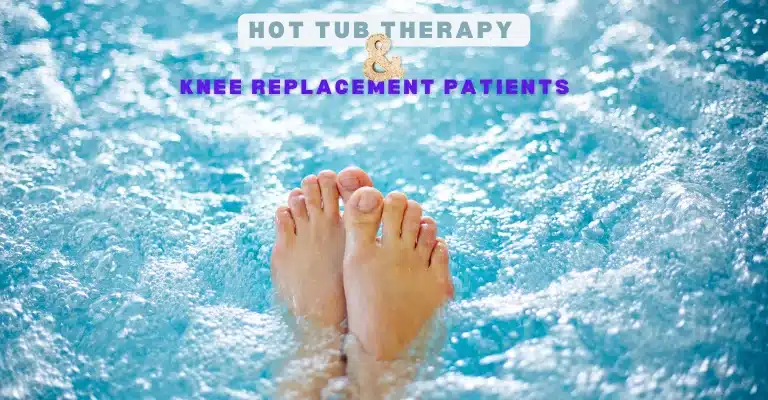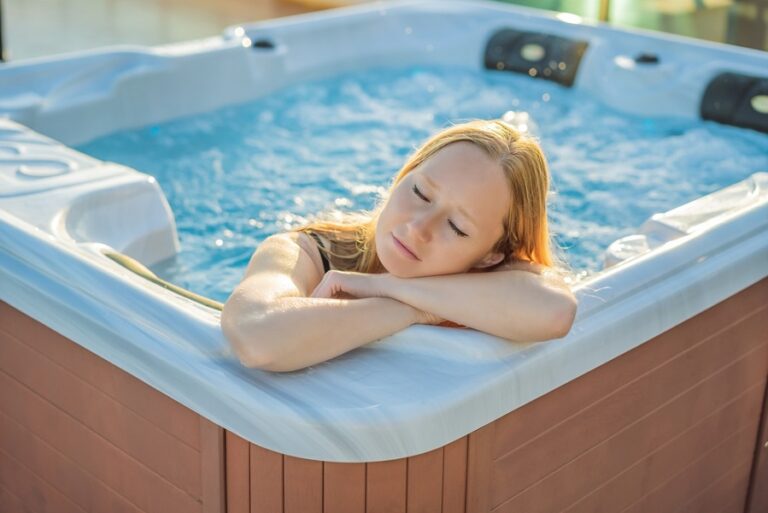Hot Tub Therapy for Knee Replacement Patients
Struggling with pain and stiffness after knee replacement? Hot tub therapy for knee replacement patients can benefit from hot tub therapy to relieve discomfort, increase flexibility, and speed up healing.
Learn safe techniques, ideal water temperatures, and expert-recommended exercises to enhance your recovery. Regain mobility faster and improve sleep quality with this gentle, effective rehabilitation method.
During rehabilitation of knee replacement patients, hot tub therapy can be a valuable tool. Hydrotherapy can help reduce pain and inflammation, improve range of motion, and promote relaxation and overall well-being.
Incorporating therapy into your post-surgery care plan and other forms of treatment can lead to faster recovery and better outcomes.
Why Hot Tub Therapy is Important for Knee Replacement Patients
Hot tub therapy can aid in recovering from a knee replacement, but proper timing and precautions are essential for safe and effective use.
Why Consider Hot Tub Therapy?
Timing and Precautions
|
Factor |
Recommendation |
Notes |
|---|---|---|
|
Incision Healing |
Wait 4–6 weeks until incisions are fully closed. |
Healing rates vary; follow your surgeon’s advice. |
|
Doctor’s Clearance |
Always consult your surgeon before use. |
Individual recovery plans can differ. |
|
Session Duration |
Start with 10–15 minutes and increase gradually. |
Monitor swelling or discomfort during sessions. |
|
Water Cleanliness |
Ensure the hot tub is properly sanitized. |
Reduces infection risks. |
|
Temperature Control |
Maintain water below 100°F (37.8°C). |
Prevents excessive heat exposure. |
Practical Tips for Use
- Start Slow – Begin with short dips and avoid prolonged soaking initially.
- Combine Therapy with Exercises – Gentle stretches or leg movements can improve flexibility.
- Listen to Your Body – Stop immediately if swelling or discomfort increases.
- Hydrate – Drink water before and after to stay hydrated and support circulation.
Risks to Watch For
- Infection Risks – An unhealed incision can allow bacteria to enter, causing infections.
- Excessive Swelling – Heat may dilate blood vessels, leading to fluid buildup.
- Delayed Recovery – Premature immersion could interfere with the healing process.
What is Hot Tub Therapy?
Hot tub therapy is a type of hydrotherapy that involves using warm water to promote healing and relaxation. It can be particularly beneficial for knee replacement patients, as it can help improve circulation, reduce inflammation, and relieve pain.
Benefits of Hot Tub Therapy for Knee Replacement Patients
There are several benefits. These include:
- Pain relief: The warm water can help soothe sore muscles and joints, reducing pain and discomfort.
- Improved range of motion: Hot tub therapy can help knee replacement patients regain mobility by loosening stiff joints and increasing flexibility.
- Reduced inflammation: The heat from the water can help reduce inflammation in the knee joint, promoting faster healing.
- Stress relief: Hot tub therapy can also help promote relaxation and reduce stress, which can be particularly beneficial for recovering from knee replacement surgery.

Types of Hydrotherapy and Aquatic Exercise
Knee replacement patients can enhance their recovery and rehabilitation through a safe and effective method.
After receiving a vasectomy, relax and allow your body to heal with a hot tub soak! Relieve discomfort by enjoying the therapeutic benefits of warm water and jets.
Hydrotherapy and aquatic exercise types can be used in hot tub therapy for knee replacement patients. These include:
Post-surgery Care for Knee Replacement Patients
After undergoing knee replacement surgery, post-surgery care is critical for a successful recovery. This care involves medical management, physical therapy, and exercise. Hot tub therapy is one exercise that can be particularly beneficial for knee replacement patients.
A hot-water tub session may help reduce pain and inflammation, improve mobility, and facilitate recovery following an injury. Using it with other post-surgery care can help speed up the recovery process and improve overall outcomes.
Post-surgery Care Options
Several post-surgery care options are available to knee replacement patients, including:
- Physical therapy: Physical therapy involves exercises and stretches designed to help improve the knee joint’s range of motion, strength, and flexibility.
- Aquatic exercise: As mentioned earlier, aquatic exercise can be particularly beneficial for knee replacement patients, as the buoyancy of the water can help reduce weight bearing on the joint, allowing for low-impact exercise and movement.
- Pain management: Pain management may involve medications or other therapies designed to help reduce pain and discomfort during recovery.
- Nutritional support: Proper nutrition is essential during recovery, and knee replacement patients may benefit from nutritional counseling or supplementation.
Incorporating Hot Tub Therapy into Your Rehabilitation Plan
If you are a knee replacement patient who is interested in incorporating hot tub therapy into your rehabilitation plan, here are some tips to help you get started:
- Talk to your healthcare provider: It is important to discuss your plans with your healthcare provider before beginning any new form of therapy. They can help determine if therapy is right for you and provide guidance on incorporating it into your overall rehabilitation plan.
- Find a qualified hot tub therapist: It is essential to work with a qualified hot tub therapist with experience working with knee replacement patients. Ask your healthcare provider or other trusted sources for recommendations.
- Prepare for your session: Before therapy, ensure you have everything, including swimsuits or towels. Consider bringing a list of questions or concerns to discuss with your therapist.
- Follow your therapist’s instructions: Your hot tub therapist will guide you on safely and effectively performing exercises and movements in the water. Follow their instructions carefully to ensure you benefit most from your therapy.
- Be patient and consistent: Like any form of therapy, hot tub therapy requires time and patience. To achieve the best results, be consistent with your sessions and follow your therapist’s recommendations.
What to Expect During a Hot Tub Therapy Session
During a therapy session, you can expect to:
- Enter a warm water pool or hot tub with your therapist.
- Perform exercises and movements designed to improve the range of motion, strength, and flexibility of the knee joint.
- Receive guidance and support from your therapist throughout the session.
- Enjoy the soothing and relaxing benefits of warm water.
Portable Solutions for Knee Hydrotherapy
Supporting knee hydrotherapy at home can be made convenient and affordable by using portable sitting tubs. There are multiple options to meet your recovery needs, whether you need soothing heat or a targeted massage.
Inflatable Hot Tubs
- Intex PureSpa – Holds 200 gallons, features hydrojets for massage, and offers a sturdy octagonal design.
- SaluSpa Helsinki – Easy to set up and store, though it lacks powerful jets.
- ZenWave Ice Pod – Designed for cold therapy but holds 116 gallons and can be filled with warm water for hydrotherapy.
Portable Bathtubs
- Foldable Bathtub – Affordable and versatile for soaking without jets.
- Inflatable Adult Bathtub – Available online for around $70, providing a budget-friendly option.
Key Considerations
- Jet Power – Opt for hydrojets over air bubbles for effective therapy.
- Water Temperature – Ensure the tub maintains a stable, comfortable temperature.
- Size and Fit – Choose a model large enough to submerge your knee comfortably.
- Setup and Storage – Look for easy-to-fill, drain, and store options.
Additional Tips
- Use a hose for filling and draining to avoid lifting heavy buckets.
- Enhance therapy with Epsom salts or other minerals, as advised by your healthcare provider.
- Follow medical guidance on water temperature and session duration to ensure safety.
Thank you for reading, and we wish you all the best on your journey to recovery.
For more information, visit Hot Tub Patio, or if you’d like to read about hot tub health benefits,













